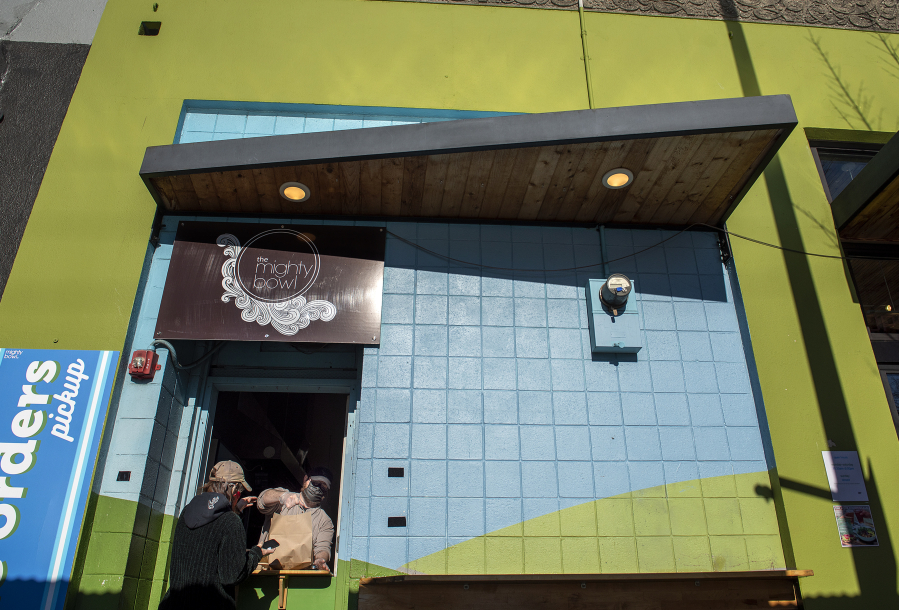Steve Valenta has spent 10 years pouring his life’s savings, his energy and his care into his Mighty Bowl restaurant in downtown Vancouver — to great success. But it’s not enough. His restaurant is running out of money.
“Just watching it unwind and unravel right before my eyes, it’s a wild way to live this human experience,” said Valenta. “It’s really hard to go through.”
The COVID-19 pandemic and associated impacts have taken their toll on local restaurants, many of which are struggling with increased costs for food and supplies on top of staffing shortages and a decline in customers.
With the omicron variant sweeping through the county, Valenta and other local restaurants have had so many staff members out sick that they’ve had to close down for days on end. And still, one of the restaurant’s prime customer bases — workers in downtown Vancouver — are working from home partially or entirely.
Valenta’s business still exists today because it received federal paycheck protection program funding, he says. He hasn’t had to lay off staff yet, but he’s had to start considering it now.
“It’s just unattainable for us to keep going,” said Valenta, adding that he’s begun rethinking his restaurant’s business model.
“What’s worked before the pandemic doesn’t work now. So, we’re having to shift gears.”
In the fourth quarter of last year, Valenta noticed the most drastic change he’d seen so far, and it came in the cost for food and supplies. In those three months alone, costs for food increased 24 percent. They had been steadily rising throughout the pandemic. His cost for to-go packaging rose 60 percent.
Out of pure desperation, he raised his prices this month by 30 percent. Then came the customer complaints.
“You’re crazy to think that you’re going to be able to get these prices for your items,” some have said.
“I agree, but what else are we to do? We don’t have any other options,” responds Valenta. Then he has seniors on fixed incomes tell him they love his food but can no longer afford it. He understands this but realizes that if everyone stops buying his food, his restaurant — like so many others — will close.
“Omicron, I can certainly testify, is the hardest time of the pandemic by far,” said Seattle restaurateur Ethan Stowell, owner of Ethan Stowell Restaurants, at a Tuesday roundtable with Washington restaurant owners, including Valenta, and Sen. Maria Cantwell, D-Wash.
The first 90 percent of restaurant sales goes to covering costs, said Stowell. The last 10 percent is where the restaurant’s profits are.
“It’s just how it is. There’s a lot of costs to open the door every day,” he said.
When there are fewer customers, there’s less profit.
“It’s not like your profit goes down 10 percent. All your profit goes away,” said Stowell.
When omicron takes out a restaurant’s staff and the shop is forced to close for a day, two or even 10, it’s another blow to the establishment.
“All those costs are still there, and you can’t bring in any business to offset those costs,” added Stowell.
Finally, the supply chain issues have piled on even further.
“As much as everyone says to raise your prices a buck or two, we’re not even talking about a buck or two. We’re talking 40 percent higher, 50 percent higher,” said Stowell. “Right now, if you wanted to run what normal food costs, a roasted chicken or a piece of salmon would be $70.
“Since we are a volume-based business, we have to offer a good value, or else we won’t get people in the door.”
The multitude of problems have caused stress to restaurant owners, many of whom have accumulated debt to stay open during the pandemic.
“Your average full-service restaurant per location is about $160,000 in debt,” said Anthony Anton, chief executive at the Washington Restaurant Association during the roundtable. That debt, adds Stowell, is often backed by the restaurant owner’s home.
“You’re not talking about just losing $160,000. You’re talking about people losing homes, you’re talking about people going bankrupt, you’re talking about people ruining their credit scores and not being able to get apartments,” Stowell said.
Cantwell and Anton are looking for ways to help. The American Rescue Plan included $29 million in funding for restaurants in the way of the Restaurant Revitalization Fund, which gave restaurants money to pay off debts for the costs of operating their businesses since the onset of the pandemic.
Problems arose, however, when many of the business that qualified for aid didn’t receive any. Of the 7,236 Washington restaurants that applied for a grant, only 3,247 — less than half — received funding before money ran out. Valenta’s restaurant was among those that did not receive a grant.
“We have to explain to people you’re not out of the woods and that with the complexity of the problem that you face, because of what’s transpired and continues to transpire, we’re going to have more loss. We don’t really want to see more loss, that’s the point,” said Cantwell.
More than 2,300 restaurants in the state closed in the first year of the pandemic.




